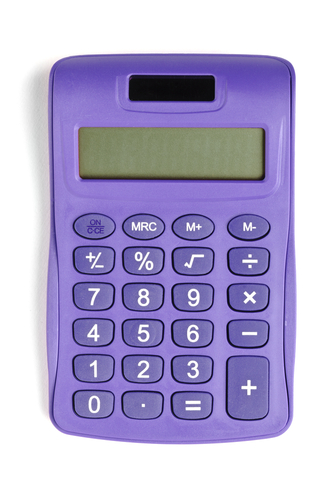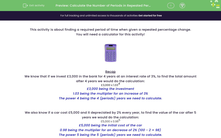This activity is about finding a required period of time when given a repeated percentage change.
You will need a calculator for this activity!

Recap
We know that if we invest £3,000 in the bank for 4 years at an interest rate of 3%, to find the total amount after 4 years we would do the calculation:
£3,000 x 1.034
£3,000 being the investment
1.03 being the multiplier for an increase of 3%
The power 4 being the 4 (periods) years we need to calculate.
We also know if a car cost £5,000 and it depreciated by 2% every year, to find the value of the car after 5 years we would do the calculation:
£5,000 x 0.985
£5,000 being the initial cost of the car
0.98 being the multiplier for an decrease of 2% (100 - 2 = 98)
The power 5 being the 5 (periods) years we need to calculate.

In this activity, we will be given all the information, but we will have to find the number of periods/years/the power.
If you are confused, a look at a typical question will help.
Example
Mr Penny invested £4,000 in the bank at an interest rate of 6%.
He wanted to leave it in there until his investment was worth more than £5,000
For how many years would Mr Penny have to leave his money in the bank?
Answer
We use the same formula as in the recap:
4,000 x 1.06n > 5,000
£4,000 the investment
1.06 being the multiplier for an increase of 6%
The power is unknown as we don't know how long it will take, so we write n
We do know that we need the total to be > £5,000
When we have the formula, we use trial and improvement to find n!
Let's try n = 1 year first
4,000 x 1.061 = 4,240 (not > 5,000)
Let's try n = 2 years
4,000 x 1.062 = 4,494.40 (not > 5,000)
Let's try n = 3 years
4,000 x 1.063 = 4,764.06 (not > 5,000)
Getting nearer!
Let's try n = 4 years
4,000 x 1.064 = 5,049.91 (this is > 5,000)
Therefore, Mr Penny would need to leave his money in the bank for 4 years to get more than £5,000
Tip: If it is taking a long time to get anywhere near the amount you need, you can skip some to get there quicker!
Let's try some of these!








